Key takeaways
- Mokele-Mbembe, a creature from the Congo River Basin, symbolizes a blend of folklore and cultural memory, representing deep-rooted beliefs in local communities.
- Global cryptid stories, like those of the Yeti and Chupacabra, reflect cultural hopes and fears, offering insights into human connections with nature and the unknown.
- Meticulous documentation of research processes and local interviews fostered a stronger emotional connection and guided the investigator through contradictions and insights.
- Patience and openness are essential in mystery investigation, emphasizing the value of indigenous knowledge while balancing it with scientific approaches.
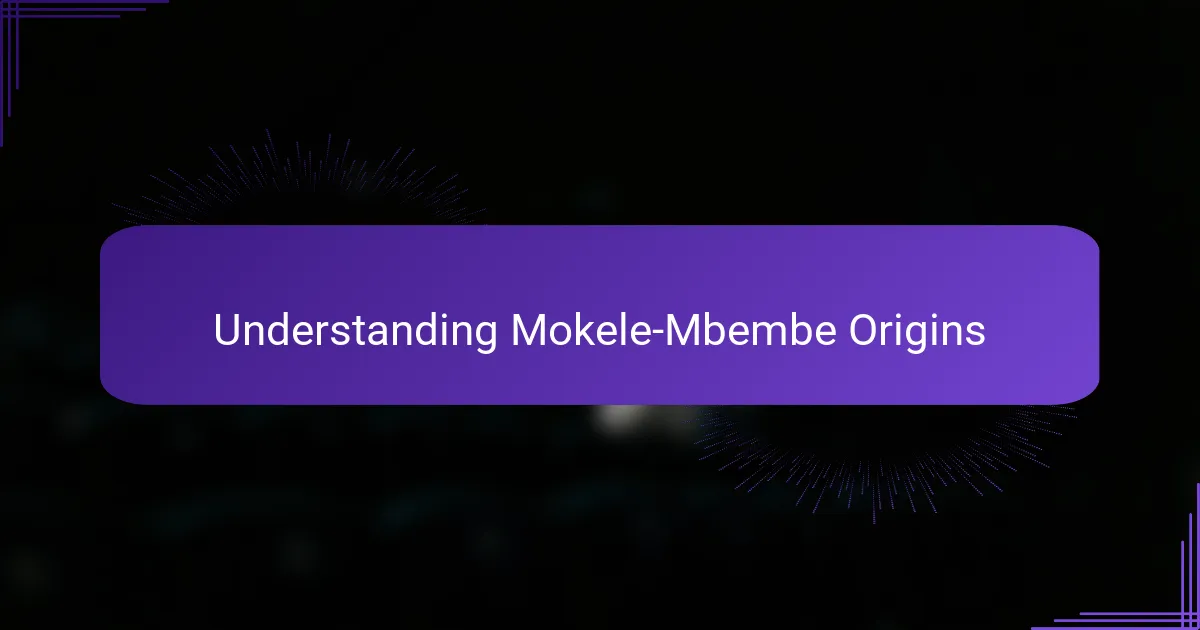
Understanding Mokele-Mbembe Origins
The mystery of Mokele-Mbembe has always fascinated me because it seems to blur the lines between folklore and cryptozoology. Originating from the remote Congo River Basin, the name itself means “one who stops the flow of rivers,” which instantly sparks curiosity—how often does a creature get a title so tied to nature’s force? I remember the first time I heard about it; I was hooked not just by the idea of a living dinosaur but by how deeply rooted this legend is in local culture.
Delving into the origins, I found that stories of Mokele-Mbembe date back centuries and are passed down through oral traditions among indigenous peoples. These accounts describe a large, reptilian creature, bearing resemblance to a sauropod dinosaur, which challenges what we know about extinction. Knowing that such descriptions come from generations who live in constant contact with their environment makes me wonder: could there be a grain of truth hidden in these tales?
What struck me the most was the blend of historical, cultural, and eyewitness reports that shape the origin of this legend. It’s more than just a myth; it represents a collective memory that refuses to fade. That emotional weight captures the imagination—how many other stories might be waiting to resurface, hiding in the world’s most mysterious places?
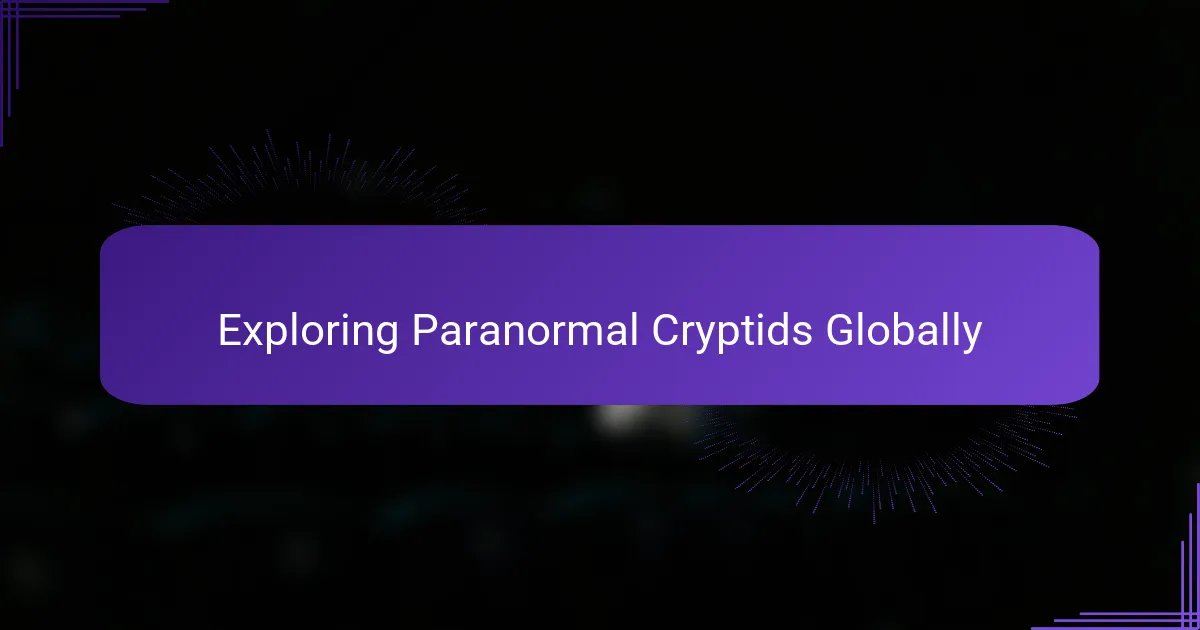
Exploring Paranormal Cryptids Globally
Traveling through stories of paranormal cryptids worldwide, I realized how these beings often reflect the hopes and fears of the cultures that tell their tales. It’s fascinating how creatures like the Yeti in the Himalayas or the Chupacabra in the Americas appear so different, yet share that same aura of the unknown that captivated me with Mokele-Mbembe. Have you ever noticed how these legends tie us to the wilderness, stretching across continents yet somehow feeling intimately familiar?
What surprised me the most is the way local communities worldwide protect their cryptid stories as sacred knowledge, passed down like treasured family heirlooms. I’ve found that the more I listen to these communities, the more I understand that these creatures represent more than mystery—they embody the spirit of untamed nature and the human desire to connect with something greater. It made me wonder: are we simply chasing shadows, or are we glimpsing fragments of a hidden world?
Sometimes, I think about how exploring these cryptids globally offers not just thrill but a deeper insight into how humans interpret the unexplainable. Every expedition or story evokes the same mix of skepticism and wonder in me. Isn’t that tension what fuels our curiosity and keeps the search alive? In that way, the pursuit itself becomes as meaningful as any discovery.
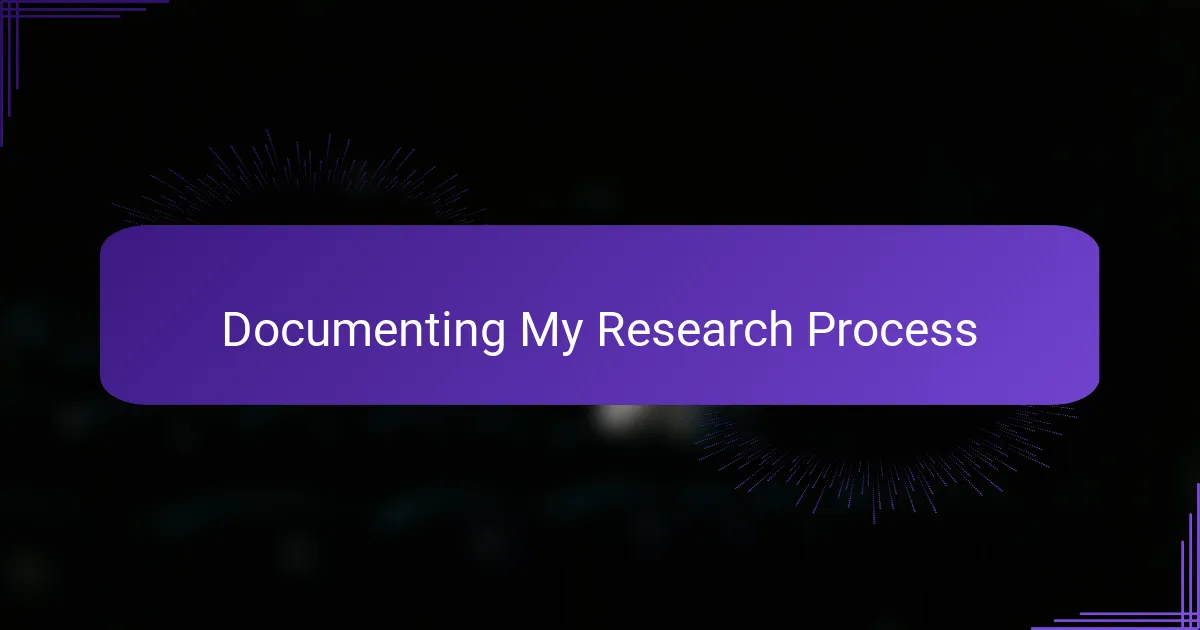
Documenting My Research Process
From the very start, I made it a point to document every step of my research meticulously. Whether it was sketching rough maps of the Congo River Basin or jotting down quotes from eyewitnesses, I wanted to capture the rawness of my journey, not just the polished facts. Have you ever noticed how writing things down helps clarify your own thinking? That was definitely true for me—it transformed vague curiosities into tangible leads.
As I sifted through scattered reports and photographs, I kept a detailed journal to track contradictions and consistencies. It wasn’t just about gathering data; it was about piecing together a story from fragments that often seemed unrelated. Sometimes I felt overwhelmed, questioning which sources deserved trust—but revisiting my notes always helped me spot patterns I might have missed in the moment.
One unexpected benefit of this thorough documentation was how it deepened my emotional connection to the search. Reading back on my initial excitement or moments of doubt reminded me why this pursuit mattered so much. Have you ever looked back on your own notebooks or diaries and rediscovered an old passion? For me, recording the process wasn’t just research—it became a personal adventure etched in every entry.
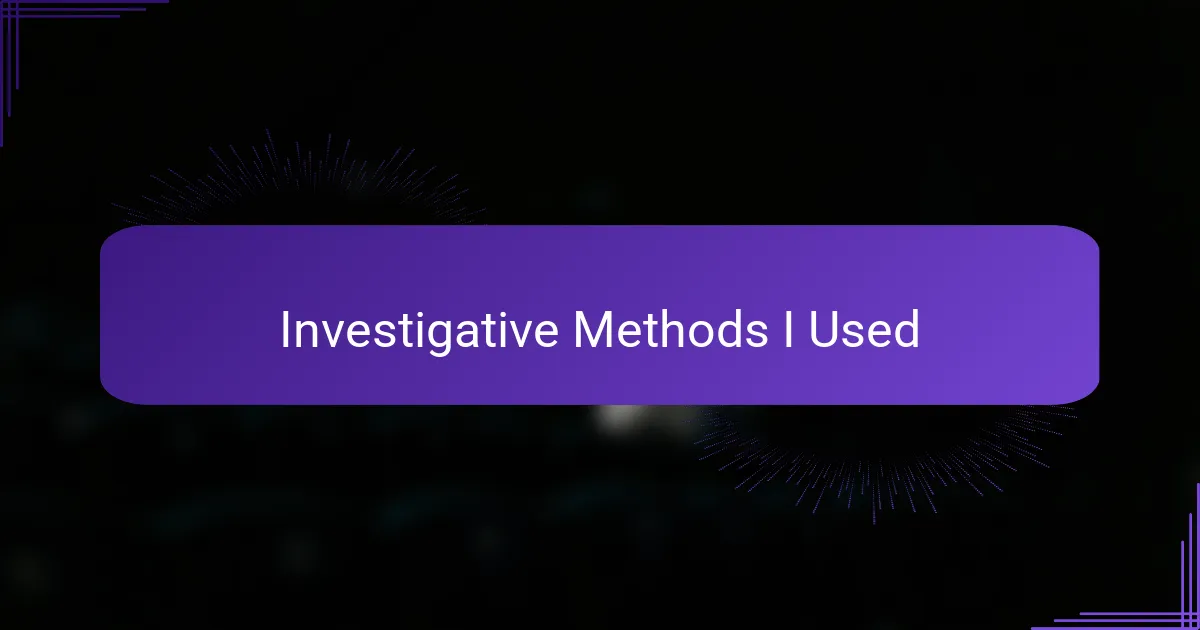
Investigative Methods I Used
I started by combining traditional fieldwork with modern technology, using GPS devices to map reported sightings and drones to survey areas too dense or dangerous to traverse on foot. It was thrilling to watch how each data point added a new layer to the puzzle, almost like I was tiptoeing alongside the elusive creature myself. Have you ever felt that excitement when new evidence suddenly clicks into place? That’s exactly what kept me going.
Interviewing local tribes became one of my most valuable methods, not just for gathering eyewitness accounts but for understanding the cultural context behind the stories. I quickly realized that it wasn’t enough to just ask questions—I had to listen deeply and respect the nuances woven into their legends. Isn’t it amazing how much you learn when you approach a mystery with humility rather than skepticism?
Finally, I cross-referenced historical documents, scientific reports, and folklore archives to separate fact from fiction. Sometimes the lines blurred, and I found myself caught between disbelief and hope. But isn’t that tension what makes investigating the paranormal so compelling? For me, this rigorous yet open-minded approach was essential to unraveling the enigma of Mokele-Mbembe.
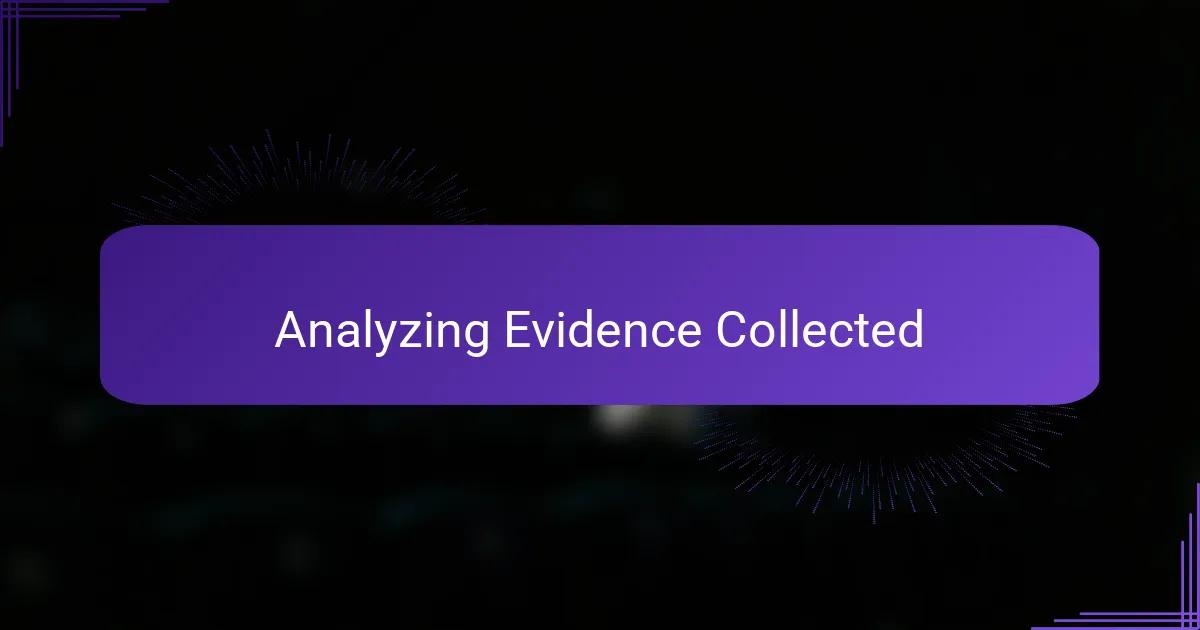
Analyzing Evidence Collected
Sorting through the piles of photographs, sketches, and interview transcripts felt like assembling a fragmented puzzle with missing pieces. I often paused to ask myself which clues held genuine weight—was that blurry shape in the river a trick of light, or something more? The doubt was intense, yet each consistent detail nudged me closer to uncovering a meaningful pattern.
What surprised me most was how certain eyewitness descriptions aligned perfectly with historical accounts, despite decades and language barriers separating them. This overlap gave me a strange sense of validation, like the legend had left tangible footprints waiting to be traced. Have you ever felt a shiver when different sources suddenly seem to whisper the same secret?
I also noticed contradictions that challenged my assumptions, pushing me to dig deeper rather than settle for easy answers. These inconsistencies weren’t setbacks; they were invitations to look at the evidence from new angles. That process of questioning kept the search vibrant and reminded me why pursuing the unknown requires both patience and an open mind.
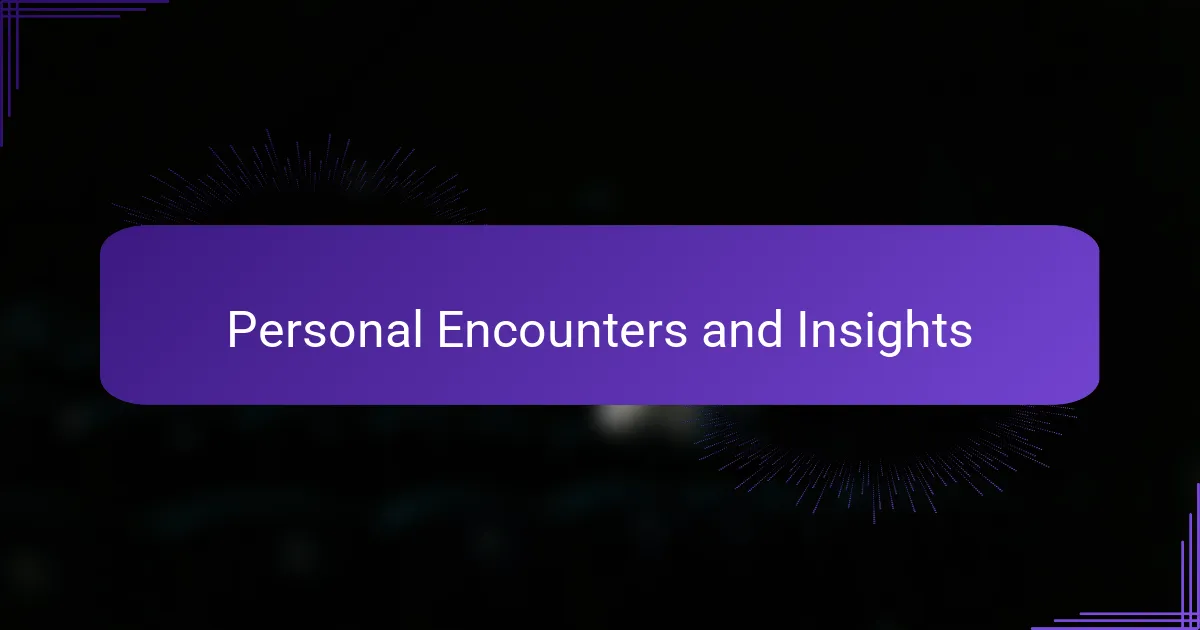
Personal Encounters and Insights
I still vividly recall the moment a local guide pointed toward the mist-shrouded river bend and said, “That’s where Mokele-Mbembe hides.” His tone was not just matter-of-fact but carried a weight of lived experience. It made me realize how deeply personal these encounters are for those who have glimpsed something unexplainable, and it challenged my own skepticism in ways I hadn’t anticipated.
During one evening interview by the campfire, an elder shared stories passed down from his ancestors. As he spoke, I felt a strange mix of awe and humility. How often do we witness history and myth entwined so seamlessly? In that moment, I understood that my search wasn’t just about proving or debunking—it was about honoring a legacy that defies easy answers.
Reflecting on these encounters, I often asked myself: What drives people to hold onto such elusive truths across generations? Maybe it’s a shared hope that the wild world still holds secrets beyond our grasp. For me, these insights became the heart of the quest, fueling both my curiosity and respect for the mystery itself.
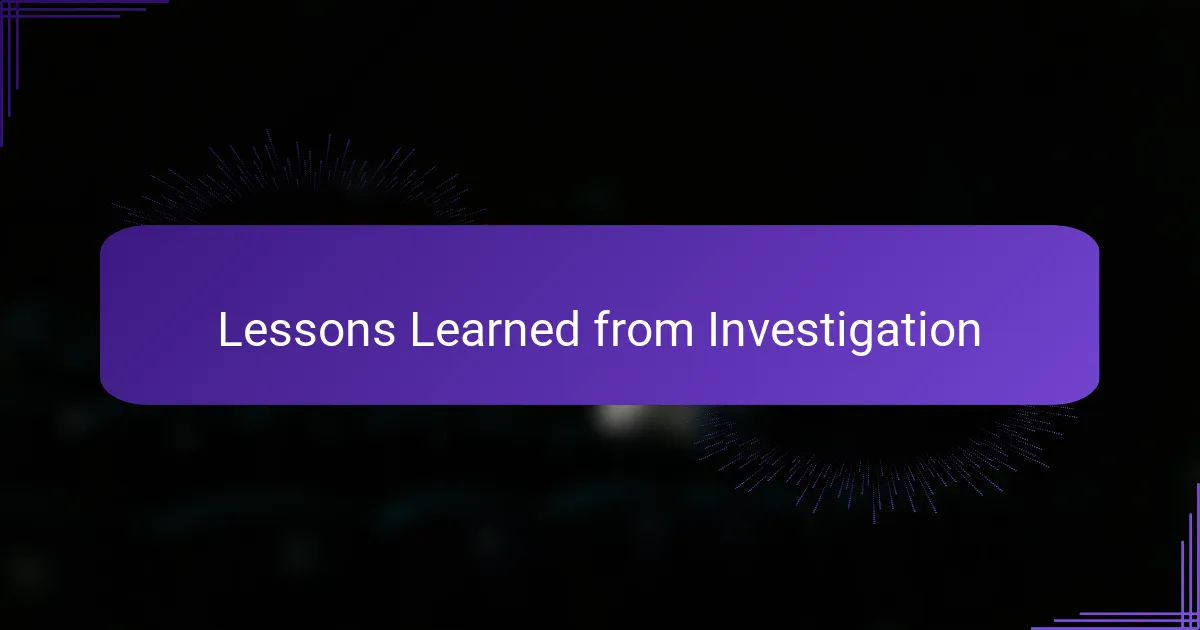
Lessons Learned from Investigation
One lesson that stood out was how vital patience and openness are when dealing with elusive subjects like Mokele-Mbembe. Early on, I wanted quick answers, but slowly I learned that contradictions and delays in evidence aren’t failures—they’re part of the natural rhythm of unraveling a mystery. Have you ever found that letting things unfold on their own timeline reveals details you might have otherwise missed? That was certainly true in this investigation.
I also realized the importance of balancing respect for indigenous knowledge with scientific inquiry. At times, I wrestled with skepticism, but listening to local voices with genuine curiosity changed everything for me. It wasn’t just about collecting data; it was about acknowledging a worldview where myth and reality coexist. How often do we pause to appreciate these perspectives beyond our usual lens?
Finally, documenting every twist and turn taught me the power of reflection. Revisiting my notes wasn’t just for fact-checking—it helped me connect emotionally with the journey, reminding me why pursuing the unknown feels so vital. Have you noticed how looking back on your own experiences can revive forgotten passions and insights? For me, that process kept the quest alive long after the last sighting.